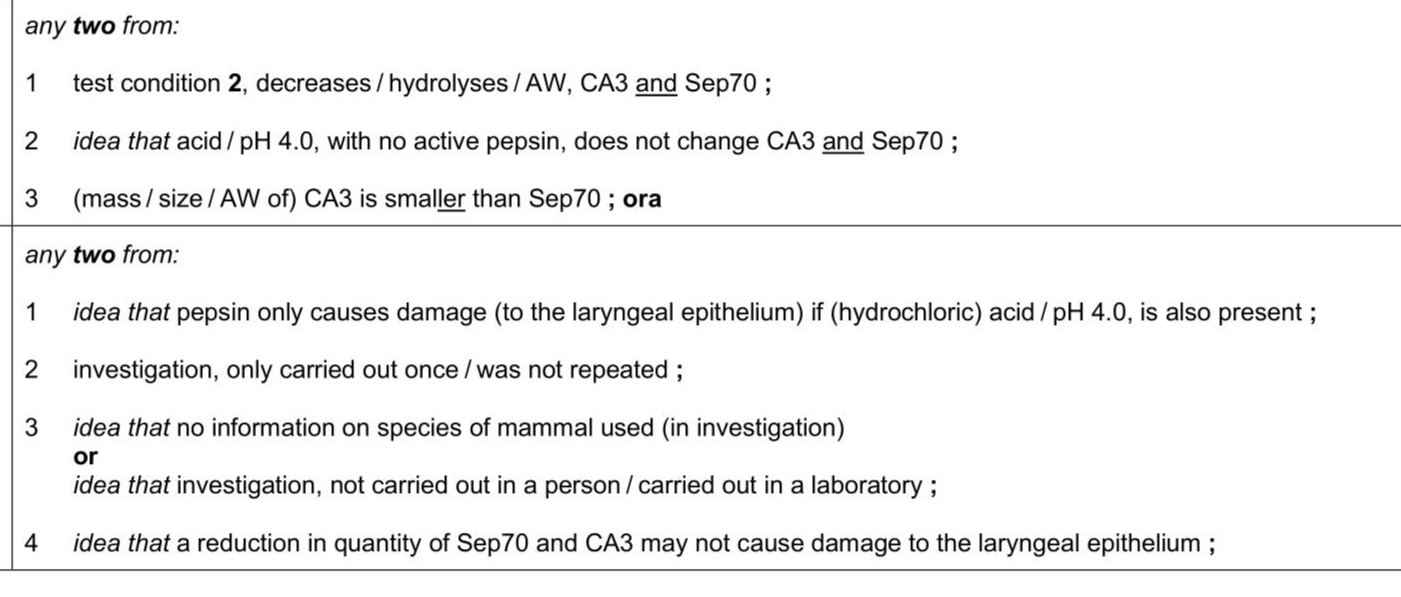Pepsin is an enzyme that is present in gastric juice. Gastric juice is secreted into the stomach of humans and many other animals. Egg albumen (egg white) contains a high proportion of protein. $$\(10 \%\)$$ albumen solution is a cloudy-white colour. This becomes colourless when pepsin is added to the $$\(10 \%\)$$ albumen solution. A student used a colorimeter to follow the progress of the hydrolysis of protein by pepsin. (c)(i)Laryngopharyngeal reflux(LPR)is a disease that occurs when gastric juice from the stomach moves up the oesophagus and into the larynx,as shown in Fig.1.4. Gastric juice can damage the laryngeal epithelium.Gastric juice contains hydrochloric acid and pepsin. Some scientists identified a reduction in the quantity of two proteins,CA3 and Sep70, present in the laryngeal epithelium of people with LPR. The scientists obtained 6 sections of mammalian laryngeal epithelium to investigate how different test conditions affect the quantity of CA3 and Sep70 in the laryngeal epithelium. Each section of laryngeal epithelium was exposed to different test conditions for 20 minutes,as shown in Table 1.1. Pepsin is inactive in the presence of the inhibitor,pepstatin. . . . . (ii) The results of this investigation were published in a scientific paper. A student who read the scientific paper concluded that pepsin causes damage to the laryngeal epithelium in people with LPR. Suggest why the results of this investigation might not support this conclusion. . . . .
Exam No:9700_s25_qp_51 Year:2025 Question No:1(c)
Answer:

Knowledge points:
10.1.1 state that infectious diseases are caused by pathogens and are transmissible
10.1.2.1 cholera – caused by the bacterium Vibrio cholerae
10.1.2.2 malaria – caused by the protoctists Plasmodium falciparum, Plasmodium malariae, Plasmodium ovale and Plasmodium vivax
10.1.2.3 tuberculosis (TB) – caused by the bacteria Mycobacterium tuberculosis and Mycobacterium bovis
10.1.2.4 HIV/AIDS – caused by the human immunodeficiency virus (HIV)
10.1.3 explain how cholera, malaria, TB and HIV are transmitted
10.1.4 discuss the biological, social and economic factors that need to be considered in the prevention and control of cholera, malaria, TB and HIV (details of the life cycle of the malarial parasite are not expected)
2.3.1 describe and draw the general structure of an amino acid and the formation and breakage of a peptide bond
2.3.2 explain the meaning of the terms primary structure, secondary structure, tertiary structure and quaternary structure of proteins
2.3.3.1 hydrophobic interactions
2.3.3.2 hydrogen bonding
2.3.3.3 ionic bonding
2.3.3.4 covalent bonding, including disulfide bonds
2.3.4 state that globular proteins are generally soluble and have physiological roles and fibrous proteins are generally insoluble and have structural roles
2.3.5 describe the structure of a molecule of haemoglobin as an example of a globular protein, including the formation of its quaternary structure from two alpha (α) chains (α–globin), two beta (β) chains (β–globin) and a haem group
2.3.6 relate the structure of haemoglobin to its function, including the importance of iron in the haem group
2.3.7 describe the structure of a molecule of collagen as an example of a fibrous protein, and the arrangement of collagen molecules to form collagen fibres
2.3.8 relate the structures of collagen molecules and collagen fibres to their function
3.1.1 state that enzymes are globular proteins that catalyse reactions inside cells (intracellular enzymes) or are secreted to catalyse reactions outside cells (extracellular enzymes)
3.1.2 explain the mode of action of enzymes in terms of an active site, enzyme–substrate complex, lowering of activation energy and enzyme specificity, including the lock-and-key hypothesis and the induced-fit hypothesis
3.1.3 investigate the progress of enzyme-catalysed reactions by measuring rates of formation of products using catalase and rates of disappearance of substrate using amylase
3.1.4 outline the use of a colorimeter for measuring the progress of enzyme-catalysed reactions that involve colour changes
Solution:
Download APP for more features
1. Tons of answers.
2. Smarter Al tools enhance your learning journey.
IOS
Download
Download
Android
Download
Download
Google Play
Download
Download
